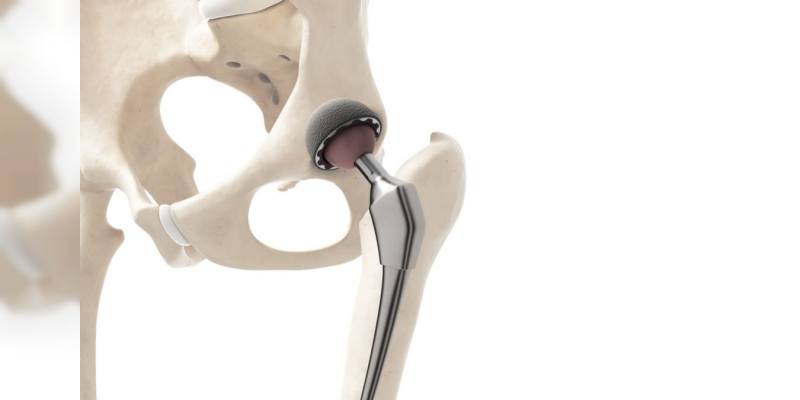The hip is one of the joints which carry load mostly in the body. The hip joint is located at the point where the femur and pelvis merge. This merged surface is covered with cartilage. Thanks to this cartilage acting as a bag, bones can easily move on each other with less friction.
There are many conditions that cause deformation in hip joint. The most common reasons are degeneration and arthritis. In addition, if the disease or injuries prevent the free flow of blood to the bone, the bone cells die and the surrounding cartilage begins to deteriorate. In that case, joints get worn. Congenital hip dysplasia and fracture cause dysfunction and wearing in joints. The joint surface becomes rough as a result of the loss of joint cartilage in the problematic hip and the cartilage cannot act as a cushion and abrasion occur due to friction of the bones.
Symptoms caused by wearing in the hip joint are started with pain due to the load on the damaged side. The patient tries to reduce the load on the hip by walking lame. The range of motion of the hip reduces due to wearing.
What is Hip Replacement?
Hip replacement is the process of replacing the deformed joint surfaces with a material called total hip replacement which is made of special materials that will perform the same function. Knee replacement was applied for the first time in the 1960s, and it is still applied thanks to the development of the technology. A prosthesis that was produced from metal and plastic is produced from metal-metal, metal-ceramic today. With each renovation, wearing feature has been developed and stability has been increased. Renovations have been made to make more contributions to the benefit of the prosthesis and to enable the surgeons carry out this surgery more comfortable.
When is Hip Replacement Surgery carried out?
Hip replacement surgery is the last stage of hip osteoarthritis treatment. The patient can apply for hip replacement surgery if s/he has an advanced disease (stage 4) and complaints of the patient should be so severe that life quality is decreased. If the patient is sick of pain, if the complaints so severe that the patient cannot sleep at night if the patient has difficulty walking and if arthritis is advanced, the patient can apply for hip replacement surgery. Otherwise, non-surgical methods are applied. Non-surgical hip osteoarthritis treatment is performed to reduce the pain, to stop and slow down the osteoarthritis, to increase the comfort of the patient. None of the treatment can rebuild the worn joints.
Some diagnosis methods can be performed to diagnose the disease and to determine the level of osteoarthritis. The first method is examination. After physical examination, x-ray is taken for final diagnosis, size, and cause of the disease. Rarely, MRI (Magnetic Resonance Imagination), tomography and blood tests can be performed if any other disease is suspected.
When is Hip Replacement Surgery carried out?
- If the hip joint is severely damaged,
- If medications, physiotherapy, intraarticular injection do not affect,
- If the patient has rheumatoid,
- If hip pain restricts daily activities such as walking, bending,
- If the pain also increases during resting, hip replacement is carried out.
How is Hip Replacement Surgery carried out?
Hip replacement surgery takes 1,5 hours on average. The operation is performed under local or general anesthesia. The operation is started with an incision made on the hip and covers attaching metal and polyethylene implants in suitable size instead of damaged part of the hip. The round tip of the femur is dissected and a new and round prosthesis is attached. The damaged surface of the hole is made flat before the new hole is attached. The ball and hole are attached. The prosthesis is fixed to the bone with bone cement.
Recovery Period after Hip Replacement
The patient may experience pain for the first a few days after hip replacement surgery, however, this pain can be taken under control with mild painkillers. Drainage is attached to discharge the accumulated blood and special socks are worn to prevent blood clotting in the vein. The patient stands up with a walker and mild exercises are started including walking. Drainage is removed next day and dressing is applied. The patient is discharged after 3-4 days.
The patient can sit down by placing her/his feet on the floor and carry out daily activities with the aim of walker. The patient comes for follow-up examination after 15 days, wound dressing is done and generally sutures are removed in this session. The physiotherapy process starts after 15 days. The patient can walk without a walker at the end of 3rd week. But, it is beneficial to use walking stick. The patient can get back to active life after 6-8 weeks. Although it is an active process, there are some points to pay attention. A good process of physiotherapy is essential for a good recovery process. This process takes about 3 months.
What to Pay Attention after Hip Replacement Surgery
- Do not sit on low objects such as the couch, taboret, prefer higher places.
- Do not lift your knees higher than your hip.
- Do not cross legs.
- Do not put your weight on your operated leg.
- Follow all instructions given by your physician.








